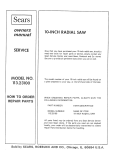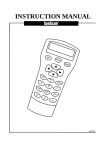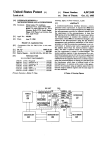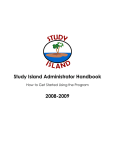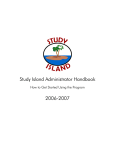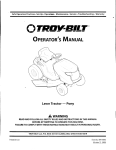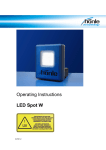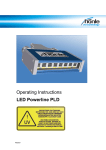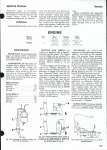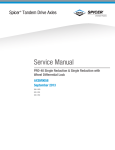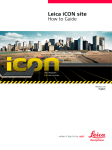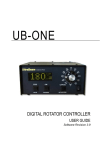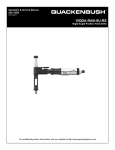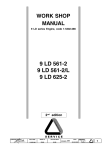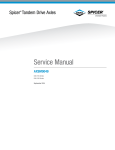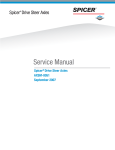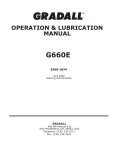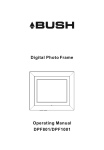Download •XL 2200 OPS Manual - FourWindsGraphics.com
Transcript
hydraulic excavators XL 2200 Excavator Owner/Operator Manual Covering Operation & Periodic Maintenance Form No. 29703, Issued 2/98, Revised 0/99 IMPORTANT Read and understand this Manual & the GRADALL and EMI Hydraulic Excavator Safety Manuals before starting, operating or performing maintenance on this machine. KEEP THESE MANUALS IN THE CAB AVERTISSEMENT! Si vous ne lisez pas l’Anglais, demandez a votre surveillant de vous donner les instructions de securite! ATENCION Si no lee Ingles, preguntele a su supervisor para las instrucciones de seguridad! VORSICHT! Wen Sie kein Enlisch lesen, bitten Sie ihren Vorgesetzten um die Sicherheitsvorschriften! Revisions • This page is provided so you may determine that this Manual is complete and current with respect to Gradall Engineering Specifications. Page Date Revision XL 2200 Excavator Owner/Operator Manual TABLE OF CONTENTS Table of Contents Introduction 2 3 Related Manuals & Decals Operator Qualifications Orientation PIN Location Fastener and Fitting Torque Models Covered 3 3 3 3 3 3 Safety Nomenclature Tools Pinch Points Other Basic Safety Issues Decals Inside Cab Decals Outside Cab Seriel No. Plates Operator’s Cab 4 5 6 7 8 11 13 15 16 Seat Adjustment Heater Air Conditioner Defroster Heater / Air Conditioner Fan Fire Extinguisher Cigarette Lighter 16 17 17 17 17 17 17 Control & Instrument Identification Electronic Monitor 18 19 Digital Display Selector Switch & Symbols U.S./Metric Unit Indicators 19 19 Caution Symbols & Alarm Checks & Servies Before Starting Engine Engine Operation 20 21 23 Starting the Cummins Engine Cold Weather Starting Aids 23 23 Normal Engine Operation 24 Stopping the Engine 24 Warm-Up & Operational Checks Adapter Attachment Installation Use Your Crawler Properly 25 26 27 Crawler Controls Speed Control 27 27 How to Operate Crawler A Typical Gradall Digging Cycle A Typical Digging Cycle Lifting and Positioning A Load 28 29 30 31 Precautions General Positioning Machine for a Lift Planning a Lift 31 31 32 32 Lubrication & Maintenance Chart 33 Lubrication & Maintenance Schedule 34 Recommended Lubricants & Capacities Torque Chart Towing 35 36 37 If You Get Stuck 37 Loading & Securing For Transport Preservation & Storage Excavator Hand Signals 38 39 41 2 Introduction This Manual provides important information regarding safe operating procedures and routine maintenance for the Gradall XL 2200 Hydraulic Excavator. Read and understand this entire Manual, along with the appropriate Owner/Operator Manual, EMI Rough Terrain Forklift Safety Manual, Gradall Material Handler Safety Manual and all instructional decals and plates before starting, operating or performing mechanical adjustments and maintenance procedures on this equipment. Keep Operator and Safety Manuals in cab. Related Manuals & Decals Separate publications are furnished with the excavator to provide information concerning safety, replacement parts, maintenance procedures, theory of operation and vendor components. All decals for your machine are available from your Gradall Distributor. He can also furnish additional manuals for your machine. Operator Qualifications This excavator has been designed for operators weighing from lQ4 to 220 pounds (47 to 100 kg) and from 59 to 73 inches (150 to 185 cm) tall. Potential operators who do not fit within these parameters should be observed while operating and driving the unit in a safe area to determine their ability for safe, efficient operation. Any operator must hold a valid driver’s license which requires acceptable age, vision, hearing, manual dexterity and response. He must also be in acceptable physical and mental condition. He should not be undergoing medical treatment or using drugs or alcohol which would violate traffic laws. Before operating the excavator at a worksite, the operator must familiarize himself with the machine by practicing in a safe, open area not hazardous to persons or property. The operator must read, understand and comply with instructions contained in the following material furnished with the excavator: • This OwnerlOperator Manual • Gradall Hydraulic Excavator Safety Manual • EMI Hydraulic Safety Manual • All Instructional decals and plates • Any additional information furnished regarding optional equipment Orientation When used to indicate direction or location, the terms “front”, “rear”, “left” and “right” indicate the point of view of a person sitting in the operator’s seat. In relation to the crawler, “front” and “rear” are determined by the location of the track drive sprockets, which are at the rear. PIN Location (Product Identification Number) Specify PIN when ordering parts and when discussing specific applications and procedures with your distributor. The PIN plate is located on front, center portion of upperstructure frame. Fastener and Fitting Torque Torque values for mechanical fasteners and hydraulic fittings are given in Appendix A, “Torque Chart”. They must be adhered to at all times. Loctite 242 must be used on all bolt threads. Loctite 545 must be used on all hydraulic fittings. Whenever a hydraulic hose is tightened, two wrenches must be used; one to tighten the hose, the other to hold it from twisting. Hoses must lie and roll free of stress. Models Covered This Manual covers XL 2200 Crawler Mounted Excavators, starting Serial Number: 0221400. 3 XL 2200 Excavator Owner/Operator Manual PIN Location Safety The following symbols are used to call your attention to safety notices: DANGER This symbol indicates an extreme hazard which would result in high probability of death or serious injury if proper precautions are not taken. This symbol indicates a hazard which could result in death or serious injury if proper precautions are not taken. WARNING CAUTION This symbol indicates a hazard which could result in injury or damage to equipment or property if proper precautions are not taken. Safe operation depends on reliable equipment and proper operating procedures. Performing the adjustments and repairs described in this Manual will help to keep your Material Handler in reliable condition. Use of the recommended operating procedures can help you avoid accidents. Because some procedures may be new to even the experienced technician, we recommend that this Manual be read, understood and followed by all who service this machine. DANGER, WARNING and CAUTION notes in this Manual will help you avoid injury and damage to the equipment. Any procedure not specifically recommended by GRADALL must be thoroughly evaluated from the standpoint of safety before it is placed in practice. If you are not sure, contact your GRADALL Distributor before operating. Do not modify this machine without written permission from GRADALL.. 4 Nomenclature Hydraulic Reservoir Valve Pressure Release Fuel Tank Compartment Hydraulic Reservoir Hydraulic Filter Mirror Telescoping Boom Main Boom Boom Rollers Engine Compartment Mirror Pump Compartment Tilt Bearing Tool Cylinder Air Cleaner Telescoping Cylinder Tilt Transmission Operator’s Cab Hoist Cylinder Swing Bearing Engine Track Battary Counterweight Track Idler Track Drive Planetary Track Roller 5 Track Drive Sprocket XL 2200 Excavator Owner/Operator Manual Tools FPO Reshoot? (Kit can be ordered under part number 8021-5004) Qty. Part No. Part Use to: 1 1 2 1 8504-1300 8504-1301 8504-1302 8504-1356 Grease Gun Hose and Coupling Grease Cartridges Box Wrench (1-7/8”) Grease fittings Adapt grease gun to fittings Provide initial supply for grease gun 1 1 1 2 1 8381-3109 8664-1304 8664-1305 8093-3117 8022-6035 Large Buttin Head Coupling Open Gear Lubricant Open Gear Lube Gun Oil Sample Kit with Mailer Spanner Tool Install and remove attachment Adapt grease gun to adjust tracks Lubricate swing & tilt Gears Apply open gear lubricant to gears Collect and submit hydraulic oil sample Adjust boom rollers 6 Pinch Points Stay clear of Pinch Points. Getting caught in a pinch point can cause series injury or death! 7 Boom Holes Bucket & Linkage Access Covers Counterweight & Another Object Boom Cradle Upperstructure & Carrier XL 2200 Excavator Owner/Operator Manual Other Basic Safety Issues Always maintain 3-point contact with grab handles and steps when climbing on and off the machine. Never Jump from the machine. Repair or replace any damaged steps and grab handles. 3 2 Perform all “Checks & Services Before Starting The Engine” (pages ?? & ??) and all “Warm-Up & Operational Checks” (page ??) at the beginning of your shift. Complete all required maintenance before operating the XL 2200. 1 Make sure all DANGER, WARNING, CAUTION and Instructional Decals are in place and legible. Clean or replace decals as required. Owners often alter their machines. Make sure your XL 2200 fits the picture on the cover of this Manual. If not, contact your Authorized Gradall Distributor before operating the machine. Keep everyone off of the machine while it is operating. Be alert for anyone who may be working nearby. Never carry a water can, equipment, or other workers’ tools or personal items on the machine. Such items can cause other workers to approach the machine without your knowledge and result in serious injury or death. Stay clear of moving fan, belts, pulleys, meshing gears, drive shafts and other moving parts. Do not operatethe XL 2200 without covers and guards in place. Be particularly careful if this is not the machine you usually operate. Read the manuals listed on page 2 and then practice operating the machine in a safe, open area to become familiar with the controls. Learn and follow your employer’s safety rules. Do not operate with bystanders or other workers nearby. Always sound the horn to warn others of unexpected machine movements—the horn button is located on top of left joystick. An automatic travel alarm warns others of machine travel in either direction. 8 Pressure may persist in hydraulic circuits long after the engine has been shut down. This pressure can cause oil (or items such as pipe plugs) to “shoot out” at high speed if pressure Is not released correctly. Refer to the XL 2200 Service Manual for proper procedures to relieve hydraulic pressure trapped in circuits. Always relieve pressure trapped in circuits before disconnecting, removing or installing hydraulic components. WARNING Always be sure attachment is resting firmly on ground and that engine is stopped before performing lubrication or maintenance procedures inside boom. Always lower boom to rest and stop engine before leaving cab. Use the boom tie-down device to secure the boom before transporting the XL 2200. Boom Tie-Down Check the operation of all tail and swing lights. LOAD RADIUS LOAD POINT HEIGHT Minimum Radius 10’ (3.0m) 15’ (4.6m) Always check Lift Capacity Chart and plan lift (pages ?? and ??) to be certain lift can be performed safely. 20’ (6.1m) Maximum Radius Above Ground Level 15’ (4.6m) 3095 @ 16’1” 2460 @ 18’7” At Ground Level Below Ground Level (1405 @ 4.9m) (1115 @ 5.7m) CAUTION: All rated loads are based on the machine being stationary and level on a firm supporting surface. For safe working loads, the user is expected to make due allowance for his particular job conditions, such as soft or uneven ground, out of level conditions, side loads, hazardous conditions, experience of personnel, etc. The operator and other personnel should fully acquaint themselves with the Operator's Manual furnished by the manufacturer before operating this machine, and rules for safe operation of equipment should be adhered to at all times. WARNING 9 Travel on grades is recommended only under the following conditions: • Boom is fully retracted • Tracks are properly adjusted • Surface is firm enough to support the machine • Surface provides adequate traction to prevent slipping • Surface is not rough enough or steep enough to cause tipping • Low travel speed is selected XL 2200 Excavator Owner/Operator Manual Operate On Roadway Only Under Following Conditions: • • Adequate protection is positioned under tracks to prevent damage to road surface. Signal persons are positioned to observe and signal the operator for safe operation and travel and to guide traffic. • Always be especially careful when using mirrors; distances are distorted and field of view is limited, especially when swinging. Always use a signal person when operating in tight quarters. • Be certain area is clear of bystanders. • All doors and covers are secured in fully closed position. • Always sound horn as a warning before traveling. • Be certain of location of buried pipelines, cables and overhead wired. DANGER DANGER DANGER Whenever rotating equipment (such as a mow er or mixer) is installed on machine, adequate shielding must be installed to deflect flying debris. Never operate such equipment with other persons within range of possible flying debris. Be certain that mower discharge is never aimed at persons, equipment or structures. As an additional precaution, safety glass and appropriate window guards must be installed on machine. Hitch Pin Shipping Pin Always install shipping pin and secure with hitch pin when preparing machine for transport. Shipping pin is stored in valve compartment. Hoist Cylinder Travel On Off-Highway Grades Is Recommended Only Under The Following Conditions: WARNING • Boom is fully retracted and parallel with tracks. • Tracks are properly adjusted. • Surface is firm enough to support unit. • Surface provides adequate traction to prevent slipping. • Surface is not rough enough or steep enough to cause tipping. • Low travel speed is selected. • There is no load in bucket, attached to boom, or in any other part of machine. 10 Decals Inside Cab Located on right cab wall P/N 8026-3009 Located on manual holder P/N 8321-1037 Located on right cab wall P/N 8091-3074 11 Located inside cab door P/N 2-8360-1011 XL 2200 Excavator Owner/Operator Manual Located on right cab wall P/N 8026-3021 (for Gradall control configuration) Located on right cab wall P/N 8026-3022 (for S.A.E. control configuration) Located on right cab wall P/N 8026-3023 (for John Deere control configuration) Located on fuse cover P/N 8091-3021 12 Decals Outside Cab Located ??????? P/N 8060-3038 Located beside pressure fill port P/N 9114-3288 Located ????? P/N 8060-3037 Located on fuel tank P/N 7702-3008 Located ??????? P/N 8060-3036 Located inside valve compartment door P/N 9108-3492 13 XL 2200 Excavator Owner/Operator Manual Located ??????? P/N 8090-3017 Located ????? P/N 8060-3039 Located ????? P/N 8060-3026 Located ????? P/N 2-8697-1197 Located ????? P/N 8021-3070 14 Serial No. Plates Machine P.I.N. Plate Located on Front Upperstructure Frame 15 Engine Located in Engine Compartment Main Hydraulic Pump Located in Pump Compartment Implement Pump Located in Pump Compartment Swing Transmission Located Beneath Boom Cradle Swing Motor Located on Swing Transmission Track Drive Motors Located Under Cover at Rear of Tracks XL 2200 Excavator Owner/Operator Manual Operator’s Cab Perform all seat adjustments with engine stopped. Accidental actuation of controls can cause serious accidents. WARNING It may become necessary to revise some adjustments to find the most comfortable operating position. Be sure to stop engine first. Lumbar Adjustment Control Control Pod Pivot Adjustment Control (See Note) Seat Back Adjustment Control Height Adjustment Control Upper Force and Aft Adjustment Control Weight Adjustment Control Lower Fore and Aft Adjustment Control Note! Raise control to unlock control pod and armrest assembly. Reposition assembly as appropriate. Be certain lock pin is fully engaged to hold unit in selected position. 16 Heater The cab is equipped with a heater located beneath the operator’s seat. Engine coolant supplied to heater is controlled by a valve at rear of engine cylinder head and a push/pull knob located on right arm rest. Raise knob fully for maximum heat or depress knob fully for no heat. The three-speed heater fan must be operated to circulate heated air. Air Conditioner (optional) An air conditioner can be furnished as optional equipment. The air conditioner is controlled by a toggle switch located on instrument/control console. Air conditioner will operate only when heater/air conditioner fan switch is positioned for operation (High, Medium or Low). Turn off engine coolant at engine for maximum cooling. Defrosting Window defrosting can be accomplished by aiming defroster fan to direct air toward windows as appropriate. Defrost action can be increased by operating heater to provide warm air. Maximum defrosting is accomplished by operating both heater and optional air conditioner to provide warm dry air to defroster fan. Heater/Air Conditioner Fan The heater fan is located within heater housing and is controlled by a rotary switch located on instrument/console. It provides three levels of air circulation for heating, defrosting and air conditioning (high, medium or low). Air is supplied to fan thru a vent in cab floor. An air filter element is provided to clean outside air flowing to fan. Service element as indicated in Lubrication and Maintenance Diagram. Operating conditions may require more frequent element cleaning or replacement. A noticeable reduction of air flow from vents indicated a need to service element. WARNING Always be certain to position boom or attachment on ground and stop engine before opening or closing door or front windows. Accidental actuation of controls can cause serious accidents. In addition to heating, defrosting and optional air conditioning the cab is equipped for varying degrees of natural ventilation. Door and upper front window must be latched in open or closed position during operation. • Cab door can be latched in fully opened position. Lever to release door from latched-open position is located near lower door hinge. • Main (upper) front window can be latched in partially or fully open position. Be certain window is secured firmly in position selected (including closed) using both latches. • Lower front window can be removed and stored in rack behind seat. Fire Extinguisher A fire extinguisher is stored on cab wall behind operator’s seat. Read and understand instructions furnished on extinguisher regarding its care and operation as well as the type of fires on which it may be used. Check often to be sure extinguisher is fully charged. Cigarette Lighter A cigarette lighter is provided on rear overhead panel. With lighter element removed, the receptacle can be used to power an auxiliary 12 VDC device equipped with an appropriate adapter. 17 XL 2200 Excavator Owner/Operator Manual Control and Instrument Identification WARNING Test your controls before operating. The control pattern illustrated is the standard Gradall control pattern. If your machine controls have been modified to any other pattern, be certain you are familiar with their functions before operating and ensure that control diagram in cab is changed to show the actual pattern. Standard Gradall control pattern is shown here. 18 Electronic Monitor Fuel Level Engine Coolant Temperature Engine Coolant Level Engine Oil Pressure Battery Charge Hydraulic Oil Temperature Hydraulic Oil Level Hydraulic Oil Suction Filter Fuel Level Low Digital Display Window Battery Charge Engine Speed Digital Display Selector Switch Engine Oil Pressure Engine Coolant Temperature Hydraulic Oil Temperature U.S. Metric Unit Indicators Ditigal Display Selector Switch & Symbols This iswitch permits operator to choose which operating value will be shown in digital display window: battery charge, engine speed, engine oil pressure, engine coolant temperature or hydraulic oil temperature. Appropriate symbol will glow (green) to indicate which value has been selected. If value displayed flashes on and off, value is outside normal operating range. U.S./Metric Unit Indicators The operator may choose to have engine oil pressure, engine coolant temperature and hydraulic oil temperature shown in U.S. or Metric units as defined beside symbols. Selection of units to be shown is made by a switch (not shown) located on bottom surface of monitor. Move switch as appropriate for U.S. units or for metric units. U.S. or Metric mode must be selected with ignition switch in OFF position. Indicator light will glow (green) to show which mode has been selected. 19 XL 2200 Excavator Owner/Operator Manual Caution Symbols & Alarm Battery Charge Symbol glows (red) in response to low battery charge (below 11.6 VDC). Engine Coolant Level Symbol glows (red) and alarm sounds if coolant level falls below acceptable operating level. Engine Coolant Temperature Symbol glows (red) if coolant temperature exceeds 214°F. (101°C.). Alarm sounds if temperature reaches 220°F. ( 104°C.). Engine Oil Pressure Symbol glows (red) if oil pressure falls below 10 psi (.7 Kg/cm2). Alarm sounds if pressure remains below 10 psi (.7 Kg/cm2) for 10 seconds or longer. Fuel Level These five lights glow (green) to indicate approximate fuel level. For example, if all five are glowing, tank is full; if only the bottom three are glowing tank is approximately half full. With no lights glowing, tank is less than 10% full. Fuel Level Low Symbol glows (red) if fuel level falls below 15% full. Hydraulic Oil Level Symbol glows (red) and alarm sounds if oil level falls below acceptable operating level. Hydraulic Oil Return Filter Symbol glows (yellow) in response to excessive resistance to flow. Cold oil can cause symbol to glow. Refer to Warm-Up & Operational Checks (page 26) for details. Hydraulic Oil Suction Filter Symbol glows (yellow) and alarm sounds in response to a few conditions. Refer to WarmUp & Operational Checks (page 26) for details. Hydraulic Oil Temperature Symbol glows (yellow) in response to excessive hydraulic temperature (1 80°F./82 °C.). Check fuel level symbols on electronic monitor and replenish as necessary. It is recommended that the unit be refueled at the end of the work shift to minimize condensation. Check engine coolant level symbol on electronic monitor and replenish as necessary. Be sure anti-freeze solution is adequate for expected temperatures. Be sure radiator and cooler fins are clean. 20 Checks & Services Before Starting Engine (To be performed at beginning of each work shift.) Complete all required maintenance before operating unit. Use extreme caution when checking items beyond your normal reach. Use an approved safety ladder. WARNING Before removing filter caps or fill plugs, wipe all dirt and greadse away from the ports. If dirt is allowed to enter these ports, it can shorten the life of o-rings, seals, packing and bearings. When adding fluids or lubricants, refer to lubricattion section of this manual to determine proper type, specification and grade to be used. If spark arrestors are required, be sure they are in place and in good working order. Inspect unit for obvious damage, vandalism and needed maintenance. Check for signs of fuel, lubricant, coolant abd hydraulic leaks. Open all access doors and look for loose fittings, clamps, components and attaching hardware. Replace hydraulic lines that are cracked, brittle, cut or show signs of abrasion. Check to be sure windows and mirrors are clean and undamaged. Also be certain mirrors are properly adjusted for operator’s position. Check hydraulic fluid level in reservoir with boom extended half way and bottom of bucket flat on ground. Refill reservoir as necessary using proper fluid. 21 XL 2200 Excavator Owner/Operator Manual Service the unit in accordance with the lubrication and maintenance diagram and schedule. Check for the presence of a fully charge fire extinguisher on wall behind operator’s seat. Replace as necessary. Read and understand instructions regarding use and application (on extinguisher). WARNING Always stop engine when refueling. Be sure area is free of open flame, sparks or any condition which could cause fuel or fuel vapor to ignite. Check fuel level symbol on electronic monitor and replenish as necessary. It is recommended that the unit be refueled at the end of work shift to minimize condensation. WARNING If it becomes necessary to replenish coolant in a hot radiator, stop engine and relieve pressure before removing the radiator cap. Relieve pressure by holding cap with heavy rags and turning cap slowly counterclockwise until sound of escaping pressure is heard. Wait a few minutes until sound of escaping pressure stops. Then remove cap cautiously. Check engine coolant level symbol on electronic monitor and replenish as necessary. Be sure anti-freeze solution is adequate for expected temperatures. Be sure radiator and oil cooler fins are clean. Oil cooler is hinged to facilitate cleaning. 22 Engine Operation Turning ignition switch to START position while engine fIywheel is rotatlng can cause serious damage to engine and/or starting motor. WARNING Starting the Cummins Engine 1. Insert ignition key and turn clockwise to RUN position while observing electronic monitor. Note! If engine is being started at beginning of work shift be sure to perform all “CHECKS AND SERVICES BEFORE STARTING ENGINE” (PAGES 22 AND 23). All monitor symbols should glow briefly as a bulb check. Following bulb check, symbols for battery charge, engine oil pressure, fuel level and hydraulic oil suction filter should continue to glow and alarm should sound. If any other symbols continue to glow, correct cause before starting engine. 2. At temperatures above 32° F. (o° C.) throttle should be at low idle. At temperatures below 32° F. (0° C.) apply full throttle when cranking. 3. Sound horn as a warning before starting engine. 4. Turn ignition switch key clockwise to START position to engage starter motor. Release key immediately when engine starts. If engine fails to start within 30 seconds, release key and allow starter motor to cool before trying again. 5. After engine starts, reduce speed to low idle and observe engine oil pressure caution symbol on electronic monitor. Symbol should go out to indicate proper engine oil pressure. If symbol continues to glow for more than fifteen seconds, stop engine and determine cause. Correct cause of malfunction before restarting engine. 6. Observe battery charge caution symbol. Symbol should go out to indicate that charging system is functioning properly. 7. Observe hydraulic oil suction filter caution symbol. Symbol may go out in a few seconds to indicate hydraulic reservoir is pressurized and oil is flowing thru suction filter properly. Cold hydraulic oil may cause suction filter symbol to continue to glow and alarm to sound. Continue to step 8. 8. Adjust engine speed to approximately 1500 RPM and perform warm up and operational checks in next section of manual. Cold Weather Starting Aids Diesel engine ignition is accomplished by heat generated when fuel/air mixture is compressed within the cylinders. Because this heat may be insufficient to start a cold engine in cold weather, the use of starting aids has become common practice. Because of the wide variety of starting aids available it would be impractical to attempt to provide specific instructions for their use in this manual. Carefully follow instructions furnished with your starting aid. If you use a starting aid employing either or a similar substance pay particular attention to manufacturer’s warnings... 23 XL 2200 Excavator Owner/Operator Manual Normal Engine Operation Always operate with engine at full throttle to prevent possibility of stalling under heavy load. WARNING Observe electronic monitor Irequently to be sure all engine systems are functioning properly. Engine Oil Pressure (minimum): Cummins - 10 to 30 psi (69 to 207 kPa) Engine Operating Temperature: Cummins - 160 to 200°F.(71 to 93°C) Battery charge indication of alternator output: Approximately 14 volts with engine running at 2000 RPM. Be alert 10r unusual noises or vibratlon. When an unusual condition is noticed, stop machine in a safe position and shut off engine. Determine cause and correct problem before continuing. Avold prolonged Idling. Idling causes engine temperature to drop and this permits formation of heavy carbon deposits and dilution’of lubricating oil by incompletely burned fuel. If the engine is not being used, turn it off. Always keep engine covers closed while engine is running. CAUTION Stopping the Engine Operate engine at idle speed for 3 to 5 rninutes before turning it off. This allows engine coolant and lubricating oil to carry excessive heat away from critical engine areas. This is especially important for turbocharged engines. Do not “gun” engine before shut down; this practice causes raw filel to remove oil film from cylinder walls and dilute lubncant in crankcase. To stop engine, turn igniaon key to “OFF” position. Always remove key from switch before leaving cab. Never leave cab with engine running. 24 Warm Up & Operational Checks To be performed at beginning of each work shift Complete all required maintenance before operating unit. The safety, efficiency and service life of your excavator will be increased by performing the following operational checks while the engine and hydraulic oil are warming to operating temperature. 1. Observe electronic monitor digital display for appropriate values while switching to each position. Leave switch positioned for hydraulic oil temperature display. 2. Observe hydraulic oil suction filter caution symbol. If symbol continues to glow after two minutes of engine operation, perform the following procedure: a. Increase engine speed to approximately half throttle. Note! b. Slowly raise and extend boom fully. c. Retract and lower boom fully and return engine speed to low idle. These boom movements should have created sufficient positive pressure in reservoir to cause suction filter light to go out. 3. Observe hydraulic oil return filter caution symbol. If symbol is still glowing, observe hydraulic oil temperature value on digital display. Normally, symbol light will go out when hydraulic oil reaches approximately 60° F. (15.6° C.). However, if this symbol flashes on and off during operation of these circuits, it can be assumed that return filter element is clogged and must be replaced. 4. Check operation of all excavator functions in both directions. 5. Check operation of travel functions in both directions and be certain that travel alarm sounds when traveling. 6. Stop engine and service all items which could not be serviced with machine in original position. WARNING 25 When excavator/crawler functions are not being used, reduce engine speed to low idle. When excavator functions are idle, there is little cooling flow thru main hydraulic pump and excessiYe heat can damage pump. Step 3 requires that hydraulic oil be at least 60° F (15.6° C.). If necessary, increase engine speed to full throttle and stall boom extend function to speed warming of hydraulic system. Note! There is very light flow from main hydraulic pump until there is demand from circuits served by the pump (all boom functions and travel). With hydraulic oil temperature within operating range. and these functions at rest, it is unlikely that return filter indicator light will glow even if the filter is clogged. XL 2200 Excavator Owner/Operator Manual Adapter Attachment Installation WARNING CAUTION 1. Keep boom in fully extended position while installing bucket. Stay clear until bucket adapter has been fitted to bucket as shown in step 2. Digging with a loose or improperly fitted bucket can cause excessive wear, shear adapter can cause bolts or cause loss of bucket. Be sure wedge bolts are secured in storage position (toward rear) and position bucket adapter above bucket bar as shown. RESHOOT 2. Lower boom until concave section of adapter contacts bucket bar. RESHOOT 3. Move adapter toward “bucket close” position until outer end of adapter contacts bucket. Ensure proper alignment and continue to close until adapter contacts stops. 4. Move wedge bolts forward and position wedge between adapter and bucket bar. Be certain wedge surfaces are flush between adapter and bar and tighten fully. Jog tool control a few times and re-tighten. Check ofter to be sure bolts remain tight. 5. Position bucket linkage as desired. RESHOOT RESHOOT RESHOOT 26 Use Your Crawler Properly 1. Travel in forward direction whenever possible (with track drive motors at rear). Traveling in reverse increases wear on sprockets and rollers. 2. Plan your work to equalize left and right turns. Constantly turning in one direction will cause track components to wear unevenly. Hitch Pins 3. Apply power to both tracks when turning. When power is applied to only one track it becomes necessary for the driving track to overcome the drag of the other track. 4. Hard digging in one spot can cause as much track wear as frequent moves. Do not neglect service to tracks and sprockets because of infrequent moves. Shipping Pin 5. Rough operation and operation on uneven ground can cause unnecessary wear and damage to track components. Reasonable operation and regular maintenance will extend track life significantly. 6. Mud, frozen mud and debris can prevent rollers from turning and cause flat spots. Clean track components as often as necessary. 7. Never park crawler units on a steep incline or on the side of a hill. This can distort roller seals and cause a loss of lubricant which could ruin the rollers. 8. Always install shipping pin and secure with hitch pins when preparing machine for transport. Shipping pin is stored on rear wall of valve compar~nent. Do not tie down front of boom. Boom Hoist Cylinder Left Track Forward Crawler Controls Track Drive Pedals/Levers: Track drive pedals/levers permit independent control of each track and its brake. Brake is released when pedal or lever is actuated and applied when pedal or lever is released. Use of controls is illustrated on next page. Left Track Reverse Right Track Reverse Engage Pedal/Lever as indicated for desired functions Speed Control Your crawler is equipped with a toggle switch to select crawler speed range. High Speed: Move toggle to right. Low Speed: Move toggle to left for maximum tractive effort and maneuverability in tight quarters. Speed changes can be made while traveling or when stopped. 27 Right Track Forward XL 2200 Excavator Owner/Operator Manual How to Operate the Crawler Practice with travel controls in a safe, open area. Front of Crawler Front of Crawler Front of Crawler Straight Forward Turn Left Turn Right A C C Front of Crawler A A C B C A D B CounterRotate Left Front of Crawler Front of Crawler D B D B D Front of Crawler CounterRotate Right Front of Crawler Reverse Right Turn Reverse Left Turn Straight Backward WARNING Avoid confusion! Before actuating track drive pedals, think about the direction you are facing with respect to the direction the crawler is facing. (Drive sprockets are at rear of c r a w l e r ) . Confusion could cause you to travel in the direction opposite that expected. 28 A Typical Gradall Digging Cycle 1. Position unit for efficient digging cycle and check for appropriate clearances. Avoid accidental actuation of controls. Always stop engine before repositioning door and windows for ventilation. WARNING 2. Stop engine and secure door and windows in desired position for ventilation. Remove shipping pin from boom and store in valve compartment. 3. Warm up engine and hydraulic oil and then move throttle to full throttle position. WARNING Test your controls before operating. The control pattern shown is the standard Gradall pattern. If controls have been modified to another pattern, be sure you are familiar with functions and ensure that diagram in cab shows actual pattern. 4. Be certain left armrest is locked in down position to energize joysticks and pedals. Practice with controls in a safe. open area. WARNING When excavator/crawler functions are not being used, reduce engine speed to low idle. When excavator functions are idle, there is little cooling flow thru main hydraulic pump and excessive heat can damage pump. Always operate with engine running at full throttle to prevent stalling under heavy load. Lower Boom Extend Boom Close Bucket *Full Speed Tilt Boom Tilt CLockwise Swing Left Swing Right Open Bucket Aux. Attachment (Press to Engage) *Boom Tilt Counterclockwise Horn Raise Boom Retract Boom *If tilt speed has been reduced for conditions (see page 20) speed can be temporarily increased to maximum by depressing FULL SPEED TILT button. Joysticks & Pedals Return to Neutral Position When Released. 29 XL 2200 Excavator Owner/Operator Manual A Typical Digging Cycle 1. Pull back on the left joystick (A) to raise the boom from the boom rest. Be sure to raise the boom far enough to clear all obstructions. 1 2. Move the right joystick to the left (G) to swing left or to the right (H) to swing the boom end to digging the site. 3. While pushing the right joystick forward (F) to extend the boom, push the left joystick forward (B) to lower the boom to position for the start of the cut. 2 3 4. Move the left joystick to the left (C) to open the bucket or to the right (D) to close the bucket for correct penetration. Teeth should angle downward slightly (about (5°). The angle may be greater for soft digging. 4 5 6 7 8 9 10 11 30 Lifting and Positioning A Load Precautions • Do not depend on machine tipping as a warning ot overload. Some load ratings are based on hydraulic lift capacity, not stability. • Hydraulic relief valve settings must be correct when lifting and positioning loads. • Suspend loads only as shown. Passing load line over open bucket can cause uncontrolled movement of load. Boom must be tilted to level position. • Always operate at full engine RPM when handling a heavy load. This prevents stalling under load. • Keep everyone clear of machine (especially the boom and suspended load). Use guide ropes to position load. • Do not travel with a suspended load. Excavators are not designed for pick and carry lifts. • Sudden swing braking can cause unexpected movemen1 of the load and tip the machine. • Be sure tracks are properly adjusted before traveling with a load. • Keep load line vertical. Side loads can cause structural damage and tip the machine. • Use appropriate lift capacity chart if uni1 has a boom extension attached. • Be thoroughly familiar with excavator hand signals (shown at end of manual). General The excavator can lift and position loads safely only if you plan the lift properly. Failure to plan a lift properly can cause death or serious injury. DANGER There is a great lift capacity difference between the excavator’s best and worst lift positions. Just because it can lift a load from one point does not mean it can safely deliver the load to any other point. For example, the second best liflcing position is with the excavator level, the boom level and fully retracted. Assume that you have just lifted the rated load (7035 pounds) from a truck with the unit in this position. You may raise the boom 2 feet, 3 inches to the very best lifting position. Also, since all loads shown on the chart are based on hydraulic limits (not stability limits) you may safely swing to any position. However~ load limits begin to be exceeded if you lower the boom below horizontal or above 10 foot LOAD POINT HEIGHT. Study “LOAD POINT HEIGHT” and “MIN. RADIUS” columns on Rated Lift Capacity Chart while reading this paragraph again. Also note how the load capacities decrease for other conditions (other columns). The point is, you must plan the lift based on the worst condition of the lift and delivery, not the best. The worst condition can only be determined by performing an UNLOADED TEST LIFT AND DELIVERY of the load. The “common sense” and “feel” an experienced operator might apply in regard to “tipping loads” DOES NOT APPLY to loads limited by hydraulic lift capacity. All loads shown on chart in cab are hydraulic lifit capacities. Exceeding these capacities can cause a relief valve to open allowing the load to fall, or in some cases, the machine to tip over. 31 XL 2200 Excavator Owner/Operator Manual Positioning Machine for A Lift Before discussing the steps in planning a lift, let’s consider the most favorable excavator positions for making a lift. Whenever possible, the machine should be on a firm, level surface when making a lift. Also, avoid traveling with a load if possible. The shorter the load radius, the greater the lift capacity. Position the unit to minimize boom extension and swing while keeping a safe distance from obstructions and excavations. Finally, position machine to gain maximum visibility of load and delivery point. If conditions do not permit a clear view, use a signal man. Planning A Lift 1. Determine the weight of the load. Weight of slings, chains and auxiliary liftng devices must be added as part of the load. Refer to lift capacity chart for weight adjustment required for bucket. Note! Lift capacities are based on machine being on a firrn, level surface and also on load being freely suspended beneath bucket adapter. 2. Move the machine to the best probable position for making the lift. 3. Perform an unloaded trial run of litt to determine maximum boom height/depth and load radius required to complete lift. 4. Measure boom height/depth from hole in adapter to ground level (same level as bottom of tracks). Be sure to allow for length of chain and height of load. 5. Measure load radius from inner corner of frame at front of cab to vertical load line and add distance to center of rota io (69 inches). 6. Refer to lift capacity chart column for required load radius. If required radius is between columns, use column for next larger radius. 7. Check the appropriate capacities for required boom heightldepth. The smaller of these capacities is the maximum is the maximum load permitted for lift conditions. 8. To determine practical working load limits the operator must also consider wind, hazardous conditions, experience of personnel and proper load handling. WARNING Measure 89 Inches The automatic boom tilt brake will not prevent boom from tilting in response to an external load. Load must be centered under bucket adapter with boom level from side to side. To lift loads, remove bucket, level boom from side to side and close adapter fully against stops. Pass chain thru adapter as shown and be certain chain is locked on itself. A chain can be used for light loads with bucket installed and adapter closed against stops. Never pass load line over open bucket. Relief valves in bucket circuit could cause unexpected dangerous movement of the load. Bucket linkage could also be damaged. 32 Lubrication & Maintenance Chart 5 3 Symbols • = Lube Fitting = Other Service = Service Both Sides 6 7 8 9 11 12 13 14 15 4 2 1 Lubricant Symbols AF - Anti-Freeze (permanent) CG - Grease (extreme presure) DF - Diesel Fuel EO - Engine Oil GL - Open Gear Lubricant GO - Multi-purpose Lube HF - Hydraulic Fluid 16 28 31 25 23 18 17 32 33 34 19 37 36 35 38 20 21 22 26 27 25 24 25 29 30 See Warning Below 51 49 46 47 48 See vendor component literature for additional lubrication and maintenance information. Lubrication Notes • Clean lubrication fittings before lubricating. • Intervals shown are for normal (8 hour day) usage and conditions. Adjust intervals for abnormal usage and conditions. • Service items indicated by dotted leaders on both sides of unit. • Drain engine and gear cases only after operation when oil is hot. • Check lubricant levels when lubricant is cool. • Clean filter and air cleaner housing and reusable elements using solvent or diesel fuel. Dry components thoroughly using lint free cloth. • Apply a light coating of engine oil to all linkage pivot points. Serious injury can result of proper adjustment procedure is not followed. See instructions on warning plate. WARNING 33 XL 2200 Excavator Owner/Operator Manual 50 CAUTION Item Service intervals are based on machine usage of 1500 hours annually. Use of your unit may vary significantly and you must adjust service frequency for your usage to obtain maximum service life. Frequency headings in the following schedule indicate a calendar limit and an operating hour limit. Always check hourmeter and date at beginning of shift to be certain services are performed at proper interval. Perform service at whichever interval occurs first. Lube Symbol Daily or Shift (10 Hour U-maximum) Lubrication & Maintenance 1. Hoist Cylinder Barrel Pivot . . . . . . . . . . . . . . . . . . . . . . . . . . . . . . . . . . . . . . . . . . . . . . . . . . . . . . . . . . . . . . . . . . . . . . . . . . . . . . . . . . . . . . . . CG 2. Swing Bearing . . . . . . . . . . . . . . . . . . . . . . . . . . . . . . . . . . . . . . . . . . . . . . . . . . . . . . . . . . . . . . . . . . . . . . . . . . . . . . . . . . . . . . . . . . . . . . . . . CG 3. Tilt Bearing . . . . . . . . . . . . . . . . . . . . . . . . . . . . . . . . . . . . . . . . . . . . . . . . . . . . . . . . . . . . . . . . . . . . . . . . . . . . . . . . . . . . . . . . . . . . . . . . . . . CG 4. Cradle Pivot . . . . . . . . . . . . . . . . . . . . . . . . . . . . . . . . . . . . . . . . . . . . . . . . . . . . . . . . . . . . . . . . . . . . . . . . . . . . . . . . . . . . . . . . . . . . . . . . . . . CG 11. Fuel Filler Cap (fill daily at end of work shift to minimize condensation) . . . . . . . . . . . . . . . . . . . . . . . . . . . . . . . . . . . . . . . . . . . . . . . . . . . . DF 13. Hydraulic Fluid Level (check with machine level boom extended half way & bottom of bucket flat on ground - if required stop engine & vent reservoir by un-seating vent valve stem of resenvoir breather [81- refill thru pressure fill port [12] using adapler P/N 8364-1564 OR refill thru main return filter [15]) . . . . . . . . . . . . . . . . . . . . . . . . . . . . . . . . . . . . . . . . . . . . . . . . . . . . . . . . . . . . . . . . . . . HF 20. Tool Link Pivot (at adapter) . . . . . . . . . . . . . . . . . . . . . . . . . . . . . . . . . . . . . . . . . . . . . . . . . . . . . . . . . . . . . . . . . . . . . . . . . . . . . . . . . . . . . . CG 21. Adapter Pivot . . . . . . . . . . . . . . . . . . . . . . . . . . . . . . . . . . . . . . . . . . . . . . . . . . . . . . . . . . . . . . . . . . . . . . . . . . . . . . . . . . . . . . . . . . . . . . . . . CG 22. Tool Link Pivot (at cylinder) . . . . . . . . . . . . . . . . . . . . . . . . . . . . . . . . . . . . . . . . . . . . . . . . . . . . . . . . . . . . . . . . . . . . . . . . . . . . . . . . . . . . . . . CG 23. Tool Cylinder Rod Pivot . . . . . . . . . . . . . . . . . . . . . . . . . . . . . . . . . . . . . . . . . . . . . . . . . . . . . . . . . . . . . . . . . . . . . . . . . . . . . . . . . . . . . . . . . . CG 24. Connectirlg Link Pivot . . . . . . . . . . . . . . . . . . . . . . . . . . . . . . . . . . . . . . . . . . . . . . . . . . . . . . . . . . . . . . . . . . . . . . . . . . . . . . . . . . . . . . . . . . . CG 25. Boom Roller Pivots . . . . . . . . . . . . . . . . . . . . . . . . . . . . . . . . . . . . . . . . . . . . . . . . . . . . . . . . . . . . . . . . . . . . . . . . . . . . . . . . . . . . . . . . . . . . . CG 26. Tool Cylinder Base Pivot . . . . . . . . . . . . . . . . . . . . . . . . . . . . . . . . . . . . . . . . . . . . . . . . . . . . . . . . . . . . . . . . . . . . . . . . . . . . . . . . . . . . . . . . . CG 27. Extension Cylinder Rod Pivot . . . . . . . . . . . . . . . . . . . . . . . . . . . . . . . . . . . . . . . . . . . . . . . . . . . . . . . . . . . . . . . . . . . . . . . . . . . . . . . . . . . . . . CG 36. Air Cleaner Condition Indicator (observe with engine running at full throttle-clean or replace primary [oute] element as required replace safety [inner] element every third primary service - item 37 is air cleaner) . . . . . . . . . . . . . . . . . . . . . . . . . . . . . . . . . . . . . . . . . . . . . CG 39. Hoist Cylinder Rod Pivot . . . . . . . . . . . . . . . . . . . . . . . . . . . . . . . . . . . . . . . . . . . . . . . . . . . . . . . . . . . . . . . . . . . . . . . . . . . . . . . . . . . . . . . . . CG 43. Crankcase Dipstick (check lubricant level & refill as required - [44 is filler cap]) . . . . . . . . . . . . . . . . . . . . . . . . . . . . . . . . . . . . . . . . . . . . . . EO Weekly (50 Hour Maximum) Lubricatlon & Maintenance (Include all previous periodic services) 7. Swing Transmission Level Cap (remove cap & fill plug [item 9] it required add lube until it runs from level cap port - Install cap & plug) GO 18. Radialor (check level & anti-freeze protection - refill as required) . . . . . . . . . . . . . . . . . . . . . . . . . . . . . . . . . . . . . . . . . . . . . . . . . . . . . . . . . AF 29. Tilt Brake Level Plug (check level & refill a required) . . . . . . . . . . . . . . . . . . . . . . . . . . . . . . . . . . . . . . . . . . . . . . . . . . . . . . . . . . . . . . . . . . . HF 30. Tilt Transmission Level Plug (check level & refill as required) . . . . . . . . . . . . . . . . . . . . . . . . . . . . . . . . . . . . . . . . . . . . . . . . . . . . . . . . . . . . . GO 35. Air Cleaner Vacuator Valve (check for damage - should be empty with engine stopped) . . . . . . . . . . . . . . . . . . . . . . . . . . . . . . . . . . . . . . . . _ 33. Fue/Water Separator (drain water) . . . . . . . . . . . . . . . . . . . . . . . . . . . . . . . . . . . . . . . . . . . . . . . . . . . . . . . . . . . . . . . . . . . . . . . . . . . . . . . . . . 40. Swing Bull Gear (apply open gear lubricant) . . . . . . . . . . . . . . . . . . . . . . . . . . . . . . . . . . . . . . . . . . . . . . . . . . . . . . . . . . . . . . . . . . . . . . . . . GL 46. Track Idler (observe for leakage - repair or replace leaking idber - add SAE 30 or 40 to repaired idler) . . . . . . . . . . . . . . . . . . . . . . . . . . . EO 47. Track Rollers (observe all rollers for leakage - repair or replace leaking rollers - add SAE 30 or 40 to repaired roller) . . . . . . . . . . . . . . . . EO 51. Phnetarg Gear Level Plug (check level with plugs in position shown & refill as necessary - Item 49 is fill plug) . . . . . . . . . . . . . . . . . . . . . GO At End of First 30 Days (250 Hours Maximum) Lubrication & Maintenance 6. Swing Transmission Drain Plug (drain & refill) . . . . . . . . . . . . . . . . . . . . . . . . . . . . . . . . . . . . . . . . . . . . . . . . . . . . . . . . . . . . . . . . . . . . . . . . GO 50. Planetary Gear Drain Plug (drain & fill to level with lugs in position shown) . . . . . . . . . . . . . . . . . . . . . . . . . . . . . . . . . . . . . . . . . . . . . . . . GO • Check torque of all Items listed in torque table (refer to operalor’s manual) . . . . . . . . . . . . . . . . . . . . . . . . . . . . . . . . . . . . . . . . . . . . . . . . . ._ Monthly (125 Hour Maximum) Lubrication & Maintenance (include all previous periodic services) 19. Drive Belt (check condition - replace as required) . . . . . . . . . . . . . . . . . . . . . . . . . . . . . . . . . . . . . . . . . . . . . . . . . . . . . . . . . . . . . . . . . . . . . ._ 28. Tilt Gear (apply open gear lubricant) . . . . . . . . . . . . . . . . . . . . . . . . . . . . . . . . . . . . . . . . . . . . . . . . . . . . . . . . . . . . . . . . . . . . . . . . . . . . . . . GL 48. Track Adjustmenl Fitting (check for proper track tension - there should be 13⁄16 in. [21 mm] sag between top of track idler & upper support rolller - adjustment must be made only by qualified maintenance person) . . . . . . . . . . . . . . . . . . . . . . . . . . . . . . . . . . . . . . . . Every 250 Hour Lubrlcation & Maintenance (include all previous periodic services) 17. Heater Air Fliter (Inspect & clean or replace as required) . . . . . . . . . . . . . . . . . . . . . . . . . . . . . . . . . . . . . . . . . . . . . . . . . . . . . . . . . . . . . . . . . 41. Engine Oil Filter (replace element at 250 hour intervals) . . . . . . . . . . . . . . . . . . . . . . . . . . . . . . . . . . . . . . . . . . . . . . . . . . . . . . . . . . . . . . . . . 42. Crankcase Drain Plug (change oil at 250 hour intervals) . . . . . . . . . . . . . . . . . . . . . . . . . . . . . . . . . . . . . . . . . . . . . . . . . . . . . . . . . . . . . . . . EO Every Four Months (500 Hour Maximum) Lubrication & Maintenance (include all previous periodic services) 38. Fuel/Water Separator (replace element) . . . . . . . . . . . . . . . . . . . . . . . . . . . . . . . . . . . . . . . . . . . . . . . . . . . . . . . . . . . . . . . . . . . . . . . . . . . . ._ Semi-Annual (750 Hours Maximum) Lubrication & Maintenance (include all previous periodic services) 5. Swing Transmission Breather (remove clean or replace) . . . . . . . . . . . . . . . . . . . . . . . . . . . . . . . . . . . . . . . . . . . . . . . . . . . . . . . . . . . . . . . . . ._ 13. Hydraulic System (have hydraulic fluid analyzed to determine condition - use test port mini-check to obtain sample - draln flush, replenish & bleed if required & clean suction screen [141 when system is drained - refer to service manual for procedure to bleed system before starting or operating unit) . . . . . . . . . . . . . . . . . . . . . . . . . . . . . . . . . . . . . . . . . . . . . . . . . . . . . . . . . . . . . . . . . . . . . . . . . . . . HF 15. Hydraulic Return Filter (replace element if it has not been replaced in previous 750 hours - also clean magnet) . . . . . . . . . . . . . . . . . . . . . ._ 31. Tilt Transmission Fill Port Breather (remove, clean or replace) . . . . . . . . . . . . . . . . . . . . . . . . . . . . . . . . . . . . . . . . . . . . . . . . . . . . . . . . . . . . . ._ 32. Tilt Brake Breather (remove clean or replace) . . . . . . . . . . . . . . . . . . . . . . . . . . . . . . . . . . . . . . . . . . . . . . . . . . . . . . . . . . . . . . . . . . . . . . . . . ._ 45. Battery (check electrolyte level & refill as required) . . . . . . . . . . . . . . . . . . . . . . . . . . . . . . . . . . . . . . . . . . . . . . . . . . . . . . . . . . . . . . . . . . . . ._ • Check torque of all items listed in torque table (refer to operator’s manual) . . . . . . . . . . . . . . . . . . . . . . . . . . . . . . . . . . . . . . . . . . . . . . . . . ._ Annual (1500 Hour Maximum Lubrication & Maintenance (include all previous periodic services) 6. Swing Transmission Drain Plug (drain & refill) . . . . . . . . . . . . . . . . . . . . . . . . . . . . . . . . . . . . . . . . . . . . . . . . . . . . . . . . . . . . . . . . . . . . . . . . GO 8. Hydraulic Resevoir Breather (replace element) . . . . . . . . . . . . . . . . . . . . . . . . . . . . . . . . . . . . . . . . . . . . . . . . . . . . . . . . . . . . . . . . . . . . . . . . ._ 13. Hydraulic System (unless hydraulic fiuid is analyzed semi-annually to check level of contamination system must be drained flushed replenished & bled annually - clean suction screen [14] when system is drained - see service manual for procedure to bleed system before starting or operating unit) . . . . . . . . . . . . . . . . . . . . . . . . . . . . . . . . . . . . . . . . . . . . . . . . . . . . . . . . . . . . . . . . . . . . . . . . . . . . . . . . . . HF 16. Joystick Plungers (raise boot & lube rounded top of each plunger) . . . . . . . . . . . . . . . . . . . . . . . . . . . . . . . . . . . . . . . . . . . . . . . . . . . . . . . CG 18. Engine Coolng System (drain & refill cooling system based on period suggested by anti-lreeze manufacturer) . . . . . . . . . . . . . . . . . . . . . . ._ 33. Tilt Brake Drain Plug (drain & refill) . . . . . . . . . . . . . . . . . . . . . . . . . . . . . . . . . . . . . . . . . . . . . . . . . . . . . . . . . . . . . . . . . . . . . . . . . . . . . . . . HF 34. Tilt Transmission Drain Plug (drain & refill) . . . . . . . . . . . . . . . . . . . . . . . . . . . . . . . . . . . . . . . . . . . . . . . . . . . . . . . . . . . . . . . . . . . . . . . . . . GO 50. Planetary Gear Drain Plug (drain & refill) . . . . . . . . . . . . . . . . . . . . . . . . . . . . . . . . . . . . . . . . . . . . . . . . . . . . . . . . . . . . . . . . . . . . . . . . . . . GO FAILURE TO USE GRADALL HYDRAULIC FILTER ELEMENTS COULD VOID WARRANTY. No. of Points 1 2 2 2 1 1 2 2 2 1 2 12 1 1 1 1 1 1 1 1 1 1 2 1 2 14 2 1 2 _ 1 1 2 1 1 1 2 1 1 1 1 1 1 _ 1 1 1 8 1 1 1 2 34 Recommended Lubricants & Capacities Specifications APPLICATION ENGLISH LITERS MIL-L-2105D 11.6 pints 5.5 50/50 mix Permanent 23.3 quarts 22 EO (engine oil) 15W-40 Mil-L-2104E 11.6 quarts 11 CG (extreme pressure lube) No. 2 _ _ _ Hydraulic System HF (hydraulic fluid) *** *** 55 gallons 208.5 Swing Bull Gear GL (open gear lubricant) _ Part NO. 8664-1304 _ _ Swing Transmission GO (multi-purpose lube) EP 85/140 MIL-L-2105D 5 quarts 4.73 HF (hydraulic fluid) *** *** Refill to lower level plug Tilt Bull Gear GL (open gear lubricant) _ Part No. 8664-13-4 _ _ Tilt Transmission GO (multi-purpose lube) EP 85/140 MIL-L-2105D 1.5 pints .71 Track Idler EO (engine oil) SAE 30-40 MIL-L-2104E 7.8 ounces ea. .23 Track Rollers EO (engine oil) SAE 30-40 MIL-L-2104E 9.6 ounces ea. .28 Crawler Planetary Engine Cooling System Engine Crankcase Grease Fittings Tilt Brake SYMBOL GRADE** GENERAL GO (multi-purpose lube) EP 80/90 AF (anti-freeze/water) Capacities* ISO *Capacities are approximate; check level to be sure. **May vary; check vendor literature in service manual for ambient temperature limits. ***Hydraulic Fluid Specifications: Pour Point -46° F.;SSU @ 100° F. 275; Flash point 442° F. Approved Supplier & Type: Mobile Mobilfluid 424. 35 XL 2200 Excavator Owner/Operator Manual Torque Chart Check torque using an accurate torque wrench to apply maximum torque value shown. DO NOT EXCEED MAXIMUM TORQUE. Exceeding maximum torque may cause fastener to fail. APPLICATION QUANTITY THREAD SIZE (GRADE) 1 Boom Roller Eccentric Keepers 24 Extension Cylinder Support 8 5⁄8 Swing Bearing 84 5⁄8 Swing Motor 2 1 Swing Transmission 8 5⁄8 Tilt Bearing 84 5⁄8 Tilt Motor 2 1 Tilt Transmission 4 5⁄8 ⁄2 - 13 (8) TORQUE (lubricated) POUND/FEET NEWTON/METERS MINIMUM MAXIMUM MINIMUM MAXIMUM 100 110 136 150 - 11 (8) 200 215 272 292 - 11 (8) 200 215 272 292 ⁄2 - 13 (8) 100 110 136 150 - 11 (8) 200 215 272 292 - 11 (8) 200 215 272 292 ⁄2 -13 (8) 100 110 136 150 200 215 272 292 - 11 (8) 36 Towing REFER TO SERVICE MANUAL FOR INSTRUCTIONS FOR TOWING CRAWLER. If you Get Stuck If unit becomes stuck in soft ground you can use the boom to help free it. Position upperstructure parallel with tracks with boom to front or rear as appropriate for boom to help push or pull unit free. Pushing works best. While actuating travel pedals/levers in appropriate direction extend or retract boom as required to push or pull to solid ground. Whether pushing or pulling, be sure to adjust boom angle as required to keep bucket imbedded in ground. 37 XL 2200 Excavator Owner/Operator Manual Loading & Securing For Transport Weight with 60 inch ditching bucket is 27,000 pounds. 1. Retract horizontal boom fully, install transport lock pin and secure with hitch pin. Pins are stored in valve compartment. 2. Align upperstructure with tracks (drive sprockets at rear.) Install two chains from holes near rear of frame to tracks as shown. 3. Attach four legged chain as shown. Using crane of adequate capacity, take most of slack from chains. 4. Pad chains as necessary to prevent damage to components and paint. Be certain right rear chain is clear of hydraulic filter. 5. Take all slack from chains and inspect rigging for safety. Use tag lines to control load during lift. 6. Position excavator as required and secure to transport using four cross chains as shown. 7. Do not tie down front of boom. 38 Preservation & Storage General Recommended short term storage practices vary with conditions at the storage site, the length of time the unit will be stored (t vo months maximum) and t’ne temperatures expected during the storage period. Obviously, some storage sites will require greater storage precautions than others. Choosing the best storage site available is one of the most important steps you can take to protect the machine. Because Gradall cannot anticipate all storage situations, we do not provide a step-by-step procedure for shot term storage. However, we do require that you review the following points and implement those appropriate to your situation: For All Situations: • This may be a good opportunity to take a sample of hydraulic fluid for analyses. • Lubricate all grease gun points until fresh lube is expelled from lube point. • Check the hourmeter and the Lubrication and Maintenance schedule. If you are close to any lubricant change period, make the change before storage. • Check level of anti-freeze protection and drain and refill if necessary to obtain proper protection. Site Conditions: • Always select a site providing a firm, level surface. 39 • Be sure site is free of natural hazards: salt or corrosive spray, mud slides, flooding, fire, etc. • If machine must remain on an unpaved surface, be sure tracks are resting on sturdy boards to prevent tracks from being frozen in soft ground.. • Whenever possible, select a site that will minimize the threat of theft damage or vandalism. • The site should afford sufficient space to allow the unit to be exercised periodically. • Apply Boeshield* T9 (Gradall Part No. 1440-4645) to exposed cylinder rods. General Considerations • Thoroughly clean all mud and debris from the machine to help protect surfaces from corrosive action. • Be sure all doors windows and covers are closed and locked. Install vandal covers if available. • Exercise all excavator functions periodically, preferably on a weekly basis. The exercise period should last until engine and hydraulic oil have reached normal operating temperature. • If it is impractical to exercise machine regularly, and if freezing temperatures are expected, remove batteries and store in a warm location. • Tape a note inside cab window indicating the person to be called in an emergency. • Always be certain to remove ignition key before leaving machine. XL 2200 Excavator Owner/Operator Manual General Considerations • Throughly clean all mud and debris from the machine to help protect surfaces from corrosive action. • Be sure all doors and windows and covers are closed and locked. Install vandal covers if available. • Exercise all excavator functions periodically, preferably on a weekly basis. The exercise period should last until engine and hydraulic oil have reached normal operating temperature. • If it is impractical to exercise machine regularly, and if freezing temperatures are expected, remove batteries and store in a warm location. • Tape a note inside cab window indicating the person to be called in an emergency. • Always be certain to remove ignition key before leaving machine. 40 Excavator Hand Signals 41 XL 2200 Excavator Owner/Operator Manual 42 The information contained in this Manual is protected by copy r i g h t. Unauthorized reproduction of this Manual, in whole or in part, in any form whatsoever, is strictly prohibited. Specifications are correct at time of publication. Howev e r, Gradall reserves the right to make any necessary changes without prior not i c e . Gradall ® is a registered trad e m a r k for Hydraulic Exc a vators, Ma te r i a l Handlers, Industrial Maintenance Machines, Attac h m e n ts and ot h e r C o m p o n e n ts m a n u fac t u r e d and marketed by The G r ad a l l Company. ISO 9 0 01 Certified CALIFORNIA Proposition 65 Warning Diesel engine exhaust and some of its constituents are known to the State of California to cause cancer, birth defects, and other reproductive harm. hydraulic excavators 406 Mill Ave. SW, New Philadelphia, Ohio 44663 • (330) 339-2211 • Fax (330) 339-8468 • www.gradall.com












































